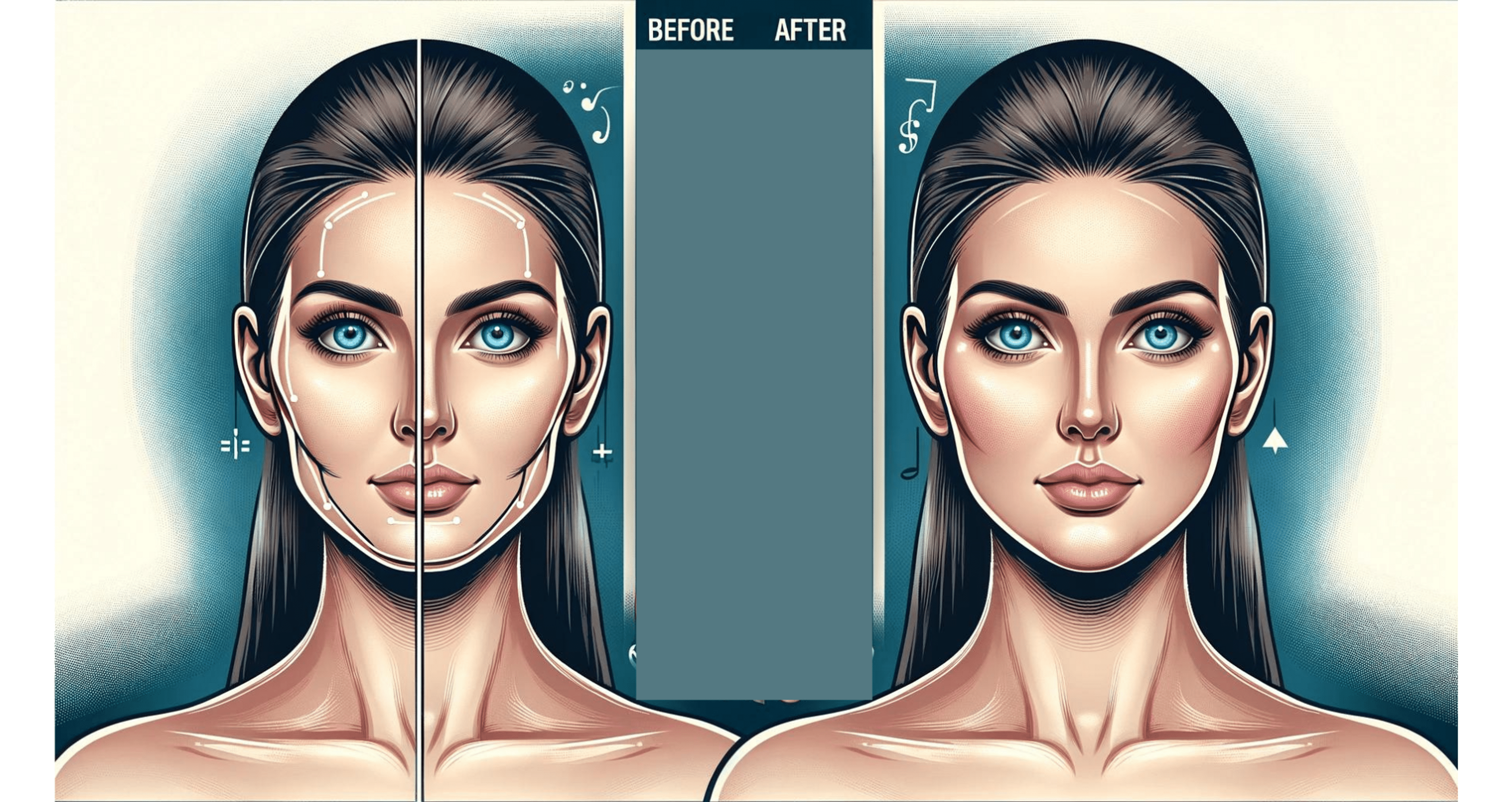
Understanding Facial Fat
In order to efficiently approach the goal of reducing facial fat, it is crucial to first comprehend what facial fat is, its causes, and why it might be more pronounced in some individuals than others. As a dynamic part of the human body, facial fat is indeed not inherently negative. It contributes to the overall contours of the face, the youthful look, and healthy appearance. Yet, some people might find themselves carrying 'excessive' facial fat that they deem aesthetically displeasing or indicative of their overall health.
Facial fat can also be tricky to fully understand. For instance, what might seem like face fat could in fact be merely bloating. This underlines the importance of distinguishing between fat and bloating. Both might lead to a fuller face, but their origins and ways to reduce them differ significantly.
The Basics of Facial Fat
Facial fat is primarily subcutaneous fat, a type of fat that sits directly under the skin. This layer of fat serves several functions – it plays a role in skin health, assists in maintaining body temperature, and acts as a buffer against external physical impacts.
Compared to other areas of the body, the face contains a greater number of fat compartments that are intricately arranged. These fat compartments contribute to the contour and overall appearance of the face.
It is also important to note that the distribution and amount of facial fat can be influenced by several factors, including age, genetics, and lifestyle. As we age, these fat compartments can diminish or shift, affecting facial appearance. Similarly, genetic factors can dictate the amount and distribution of facial fat, partly explaining why some individuals might have naturally fuller faces than others.
Factors Contributing to Facial Fat
Movements towards understanding the diverse influences on facial fat lead us to discuss a few common contributing factors:
-
Diet: A diet high in fat, sodium, and alcohol can lead to an increase in facial fat. Overeating, particularly foods that encourage fat storage, can lead to overall weight gain, which could manifest in the face.
-
Fluid retention: Commonly known as water weight, fluid retention can make your face appear puffier or swollen.
-
Lack of physical activity: Regular physical activity is needed to maintain a healthy body weight and fat percentage. A sedentary lifestyle can lead to weight gain, which could show in the face.
-
Genetics: Just as genetics play a role in our body types, it also influences where and how your body stores fat, including the face.
Distinguishing Between Fat and Bloating
In the quest for facial slimness, one must distinguish between genuine face fat and bloating. Bloating or puffiness in the face can be a result of many factors such as fluid retention, allergy reactions, or a response to certain foods. Fluid retention, in particular, can give an impression of a fattier face even though it's largely temporary and can fluctuate based on diet and hormonal changes in the body.
Tackling facial bloating, thus, requires a different approach to reducing actual facial fat. This might include steps such as reducing salt intake, staying hydrated, and avoiding allergenic foods that might cause inflammation.
Having a solid understanding of facial fat, its causes, and differentiation from bloating can guide the next steps towards effective face fat reduction strategies suited to your personal needs and lifestyle. Importantly, always remember that everyone's face is unique and these natural variations are what make us who we are.
Lifestyle Changes to Reduce Facial Fat
In order to effectively reduce facial fat, it's crucial to understand the comprehensive strategy that involves lifestyle adjustments. The purpose of these changes is not only to tackle the facial fat, but to reduce overall body fat. Let's take a closer look at how a balanced diet, adequate hydration, and regular exercise can influence this.
Dietary Adjustments for Overall Fat Loss
The first step towards reducing facial fat requires implementing dietary adjustments. In order to achieve overall fat loss, which includes facial fat, attention should be given to the type and amount of food we consume.
It's crucial to eat a balanced diet, which translates into consuming an appropriate amount of macronutrients (protein, carbohydrates, and fats) and micronutrients (vitamins and minerals). Studies have found that a high-protein diet can help in fat loss, by reducing hunger and boosting metabolism.
Limiting processed foods and sugars is also beneficial. These foods have a high number of calories and low nutritional value, leading to weight gain, including facial fat.
Incorporating more fruits and vegetables, whole grains, lean proteins, and healthy fats in your diet can promote fat loss and keep you healthy.
The Role of Hydration in Reducing Bloat
Staying well-hydrated plays a vital role in the overall well-being of our body, including reducing facial bloating. Staying well-hydrated helps your body to remove excess sodium which is a significant contributor to facial bloating. Drinking plenty of water also prevents dehydration, which can lead your body to retain water in unusual places, including your face, leading it to look swollen and puffed. Thus, regular and ample water intake should be part of your strategy to get rid of face fat.
While the optimal amount of water intake can vary, an average guideline is to drink at least 8 glasses of water per day. However, your water needs may increase based on various factors such as activity level, climate, or pregnancy.
Exercise to Support Fat Loss
Physical exercise is another key element that supports overall weight loss, contributing to a reduction in the amount of fat stored in various body parts, including the face.
While spot reduction, or the idea of losing fat from a single area of the body, is a widely debunked myth, regular and comprehensive exercise can facilitate overall weight loss, including on the face.
Strength training and aerobic exercises can help in overall fat loss. Strength training exercises help in muscle building which in turn accelerates metabolism, aiding weight loss. Aerobic exercises like walking, running, swimming, increase heart rate and burn calories, contributing to weight loss.
Additionally, certain facial exercises may help you to tone facial muscles, making your face appear slimmer. However, their effectiveness in fat reduction is less understood and more research is needed in this area.
The key idea here is to incorporate a regular, comprehensive workout routine, augment it with appropriate dietary measures and maintain proper hydration for effective reduction of facial fat. Remember, the aim is not just to "get rid of fat" but to adopt a healthier lifestyle that supports overall wellbeing.
Targeted Exercises and Treatments
While general weight loss and a healthy lifestyle can contribute effectively to reducing fat in your face, there are also some targeted exercises and treatments that might help to tone your face and deliver more immediate results. In this section, we'll explore facial exercises, their effectiveness, and some of the available cosmetic treatments for facial fat. Lastly, we'll delve into the safety and effectiveness of these treatments.
Facial Exercises: Do They Work?
Facial exercises have quickly gained recognition in recent years owing to their potential in toning facial muscles and improving skin appearance. They usually involve performing specific routines that target the facial muscles, such as eyebrow raises, smiling exercises, and cheek lifts. According to a study published in JAMA Dermatology, consistent facial exercises over 20 weeks resulted in improved facial appearance and younger-looking skin in middle-aged women.
However, while they can contribute to an overall healthier appearance by tightening your facial muscles, they are not a standalone solution for shedding face fat. Any excess body fat, including facial fat, is best addressed through a combination of a balanced diet, regular exercise, and a healthy lifestyle.
Cosmetic Treatments for Facial Fat
For more immediate results, several treatments specifically target facial fat. One of the most common is facial liposuction, a surgical procedure that removes fat deposits in the face. Normally performed by a plastic surgeon, facial liposuction can result in a more defined face structure and a youthful appearance.
Alternatively, there are non-surgical treatments available such as CoolSculpting and Kybella. CoolSculpting employs a technique called cryolipolysis that freezes and destroys fat cells, while Kybella involves injecting a synthetic form of deoxycholic acid to break down and absorb fat. Both treatments require multiple sessions for the best results.
Safety and Effectiveness of Treatments
As with all medical procedures and treatments, it's essential to consider the safety and effectiveness of the above treatments for facial fat.
Facial liposuction, while effective, is an invasive procedure that carries risks including nerve injury, scarring, and adverse reactions to anesthesia. Recovery time is also a consideration, typically taking several weeks.
As for CoolSculpting and Kybella, they are non-invasive alternatives and typically have fewer risks compared to surgical treatments. However, they may cause side effects such as temporary redness, swelling, or numbness in the treated areas. Also, it's important to remember that multiple treatments are usually needed to achieve the desired results.
Regardless of the method you choose, it's crucial to consult with a healthcare professional or a qualified dermatologist to understand all the potential risks and benefits. Remember to also maintain a healthy lifestyle alongside these treatments for sustainable results and overall wellness.
In Summary
The aim of this blog post was to explore the nuanced nature of facial fat while providing comprehensive strategies centered around lifestyle changes, and when necessary, cosmetic treatments, in order to manage it effectively.
Facial fat is primarily comprised of subcutaneous fat which is important for skin health and facial appearance. Factors influencing the distribution and quantity of facial fat are age, genetics, and lifestyle. Understanding the difference between actual facial fat and mere bloating is key to successful management.
The effective reduction of facial fat involves changes in the three fundamental facets of our life:
-
Diet: Implement dietary adjustments and focus on a balanced diet with an adequate amount of macro and micronutrients. A high-protein diet is beneficial in fat loss.
-
Hydration: Proper Hydration could help your body remove excess sodium that can cause facial bloating. Regular drinking of water is a simple and effect
ive approach.
- Exercise: A comprehensive exercise routine combining strength training and aerobic exercises aids in overall fat loss, thereby reducing facial fat. Although certain facial exercises are advocated, their effect on fat reduction needs further research.
In addition to these customary strategies, there are targeted exercises and treatments like facial liposuction, CoolSculpting and Kybella that can possibly speed up the process of reducing facial fat. However, it is significantly important to discuss with healthcare professionals about the safety and effectiveness of these treatments before choosing to use them.
The focus of any plan of action should be adopting a holistic approach towards health. Consequently, the action steps should emphasize:
-
Modify the Diet: Implement changes in the diet focusing on consuming more lean proteins, fruits, and vegetables while limiting the intake of processed foods and sugars.
-
Stay Hydrated: Maintain a regimen of regular water intake, aim to drink at least 8 glasses of water per day or as required based on your activity level, climate, or state of health.
-
Integrate a Regular Exercise Routine: Introduce regular physical exercise into your daily schedule. Incorporate a blend of strength training and aerobic exercises.
-
Consult a Healthcare Professional: For those considering fat reduction treatments, consult with a healthcare professional or a qualified dermatologist. Understand all the potential risks and benefits before opting for these procedures.
In culmination, the goal is not just reducing facial fat, but fostering a healthier lifestyle that aligns with your overall well-being. All this essential knowledge and these concrete steps should be the guiding principles on your journey to a healthier you.













